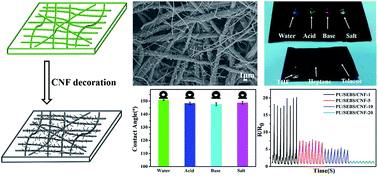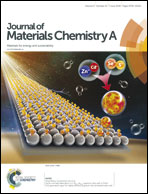A super-hydrophobic and electrically conductive nanofibrous membrane for a chemical vapor sensor†
Abstract
Electrically conductive polymer composites (CPCs) are a good candidate for chemical vapor sensors because of their lightweight, flexibility and tunable conductivity, and have promising applications in the detection of the leakage of chemical vapors. However, major challenges remain for the development of CPC based chemical vapor sensors that are mechanically robust, anti-corrosive, and sensitive to both polar and nonpolar chemical vapors. Here, a flexible and super-hydrophobic nanofibrous membrane was prepared by ultrasonication induced carbon nanofiber (CNF) decoration onto a blend polyurethane (PU)/polystyrene-block-poly(ethylene-co-butylene)-block-polystyrene (SEBS) nanofiber surface. CNFs were uniformly distributed on the nanofiber surface, forming a conductive network. The introduction of CNFs greatly improved the mechanical and conductive properties of the nanofibrous membrane. The super-hydrophobic and super-oleophilic nanofiber composite mat could repel corrosive solutions including salt, acidic and alkaline solutions, while it could be easily wetted by different solvents, which was beneficial to the quick adsorption of chemical vapors. Furthermore, the nanofiber composite could keep the stability of the electrical conductivity when it was exposed to a very humid environment. It was found that the conductive nanofibrous membrane was sensitive to both polar and non-polar vapors, and displayed excellent recyclability of the sensing performance.



 Please wait while we load your content...
Please wait while we load your content...